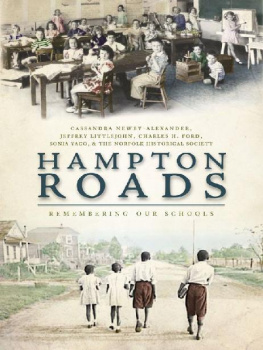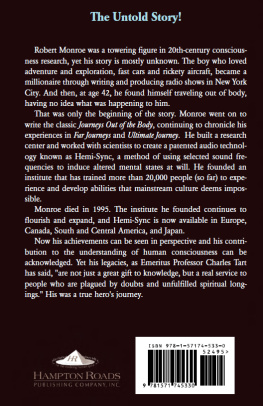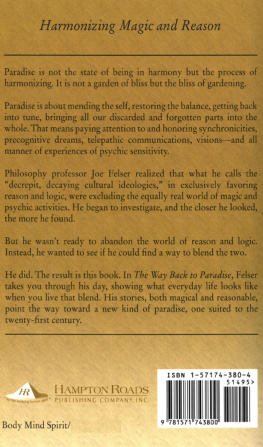Published by The History Press
Charleston, SC 29403
www.historypress.net
Copyright 2015 by Tamy Kay Thompson
All rights reserved
First published 2015
e-book edition 2015
ISBN 978.1.62585.519.0
Library of Congress Control Number: 2015942730
print edition ISBN 978.1.62619.988.0
Notice: The information in this book is true and complete to the best of our knowledge. It is offered without guarantee on the part of the author or The History Press. The author and The History Press disclaim all liability in connection with the use of this book.
All rights reserved. No part of this book may be reproduced or transmitted in any form whatsoever without prior written permission from the publisher except in the case of brief quotations embodied in critical articles and reviews.
For my husband, Davemy chauffeur, computer technician and biggest supporter.
CONTENTS
INTRODUCTION
Welcome to the Hampton Roads area of Virginia, which refers to the southeasternmost tip of the state, east of the Fall Line where the land is flat and the brackish waterways are affected by the tide. To the west of the Fall Line, an invisible vertical line running alongside I-95, the terrain steadily becomes more mountainous, the first waterfalls can be seen and the salty water turns fresh. Hampton Roads includes but is not limited to the Southside (Virginia Beach and Norfolk), the peninsula (Newport News and Hampton), Gloucester and the Historic Triangle (Jamestown, Williamsburg and Yorktown).
Virginia, and Hampton Roads in particular, is truly Americas birthplace: eight different U.S. presidents were born in Virginia, the first permanent English settlement was established in Jamestown and three major American wars were fought in Hampton Roads. Virginia is named after Queen Elizabeth I (15331603), who was known as the Virgin Queen of England (and Ireland) because she never wed. The flag of Virginia, adopted in 1861, is the obverse side of the state seal and depicts the personified virtues, called Virtus, with a bare left breast (the only nudity among the fifty seals). She is crushing Tyranny (Great Britain) underfoot, surrounded by the motto Sic semper tyrannis (Thus always to tyrants). These facts concerning Virginias early years sum up the state perfectly.
The history of Virginia is steeped in folklore, legends and exaggerated tales, sometimes making it difficult to find an accurate version of the truth. But in all of the different versions, one undisputed fact emergesthe history of Virginia is a fascinating one. On our upcoming tour, you will travel through eight cities and visit over thirty historical sites, including several haunted houses, a hotel, a mental institution, a howling cave, a cursed tree and, of course, a few ancient cemeteries. You will encounter tales of piracy, the first American conspiracy theory, a falsely accused witch who was acquitted three hundred years too late and the final resting place for the first African American born in America. You will even search for buried treasure, learn about the first American fairy tale and walk in Pocahontass footsteps. Along the way, you will be treated to some beautiful scenery, too, with the bluest skies and the most picturesque beaches. As Captain John Smith wrote of Virginia in 1612, Heaven and Earth never agreed better to frame a place for mans habitation.
THE SOUTHSIDE
We will start our tour of the Southside (the Virginian cities of Hampton Roads south of the James River) in Virginia Beach, the longest beach resort city in the world; Virginias tidal shoreline measures 1,200 miles in length. Though not ideal for surfing, the riptides on the Southside can be deadly just the same. Strong currents can pull a swimmer or body-boarder offshore in a matter of minutes. A study from 1998 to 2008 revealed that a total of thirty-three people have drowned at the two most popular beaches on the Southside, Oceanfront in Virginia Beach and Ocean View in Norfolk.
And riptides arent the only danger at the beachthere is also the occasional shark attack. Since the mid-1950s when the International Shark Attack File began, a dozen shark attacks have been recorded in Virginia. One of the most memorable Southside attacks occurred in 2001 when a ten-year-old boy was attacked while wading in four feet of water with his father. Unfortunately, the boy died shortly after from the injuries he sustained.
Since it was established in 1634, Virginia Beach has become a great vacation spot with delicious food, trendy shopping and thriving nightclubs. It also offers fishing, boating and swimming in the Atlantic Ocean with access to the Chesapeake Bay, which is largely considered a dead zone today due to the lack of oxygen in the water. The Southside has also been home to TV evangelist Pat Robertson (700 Club) and musician Clarence Clemons (Bruce Springsteen and the E Street Band). Of course, the Southside has its share of historical sites, such as the beautiful Cavalier Hotel, located at 4201 Atlantic Avenue in Virginia Beach.
The Cavalier on the Hill. Photo by author.
CAVALIER HOTEL
The original hotel, situated atop a hill, was made from cement-encased steel, and then half a million bricks were added to the structure. The hotel was completely fireproof before the term fireproof was even coined. It took about a year to build, opening in 1927 as the building made from the most bricks in Virginia. To increase tourism, a train ran straight from Ohio and Chicago to the Cavalier. Aptly, the train was called the Cavalier, and its motto was Take the Cavalier to the Cavalier right up until the trains disuse in the 1940s.
There was no electric refrigeration system when the hotel originally opened; only large blocks of ice to keep perishable items cold. Likewise, there was no running water as we know it; instead, there was a large tub of ice on the roof of the hotel. The ice would melt and run down gravity-powered pipes into the hotel, so the water running out of the faucets was only as warm as the suns rays could make it. The bathtubs were only equipped to run cold salt water directly in from the ocean, making for a frigid bath during the winter months.
The hotel featured luxurious amenities for its time, such as the swimming pool on the roof, which was filled with fresh seawater until the 1970s. The hotel lobby contained a doctors office, a barbershop and a photographers studio for the guests convenience. Plus, there was a stock brokerage office with a ticker tape directly from the New York Stock Exchange. A radio station (WSEA), the third in America to broadcast coast to coast, was located in the hotel as well.
Many famous people have stayed at the Cavalier since it opened, such as Adolph Coors, the original beer tycoon himself, who vacationed at the Cavalier Hotel in the summer of 1929. Coors managed to make it through the early years of Prohibition by manufacturing ceramics, inventing near beer and providing malt to the Hersheys Company for its malted chocolate balls. He may have made it through Prohibition, but he couldnt make it through the Great Depression; instead, he plunged headfirst from his sixth-floor balcony at the Cavalier Hotel and died on June 5, 1929.














